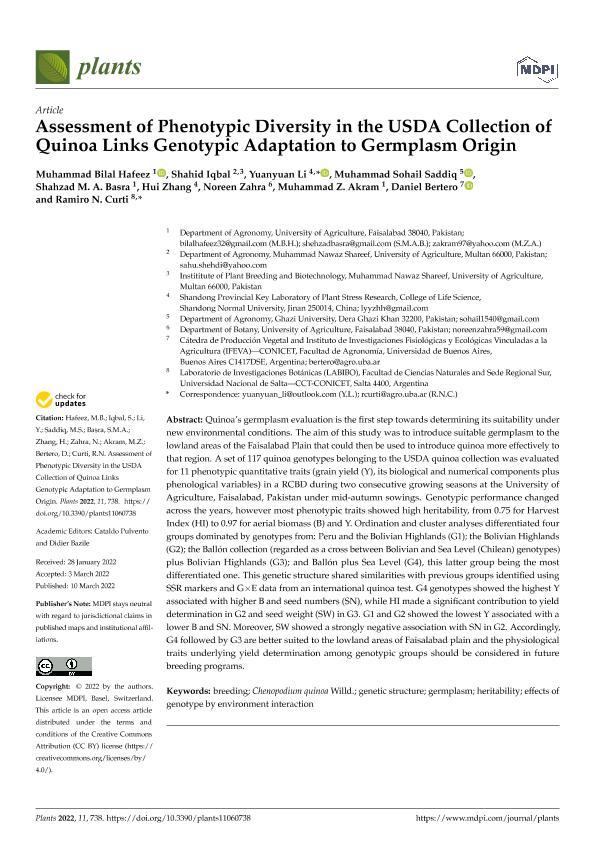Artículo
Assessment of phenotypic diversity in the USDA collection of quinoa links genotypic adaptation to germplasm origin
Hafeez, Muhammad Bilal; Iqbal, Shahid; Li, Yuanyuan; Saddiq, Muhammad Sohail; Basra, Shahzad M. A.; Zhang, Hui; Zahra, Noreen; Akram, Muhammad Z.; Bertero, Hector Daniel ; Curti, Ramiro Nestor
; Curti, Ramiro Nestor
 ; Curti, Ramiro Nestor
; Curti, Ramiro Nestor
Fecha de publicación:
03/2022
Editorial:
Multidisciplinary Digital Publishing Institute
Revista:
Plants
e-ISSN:
2223-7747
Idioma:
Inglés
Tipo de recurso:
Artículo publicado
Clasificación temática:
Resumen
Quinoa’s germplasm evaluation is the first step towards determining its suitability under new environmental conditions. The aim of this study was to introduce suitable germplasm to the lowland areas of the Faisalabad Plain that could then be used to introduce quinoa more effectively to that region. A set of 117 quinoa genotypes belonging to the USDA quinoa collection was evaluated for 11 phenotypic quantitative traits (grain yield (Y), its biological and numerical components plus phenological variables) in a RCBD during two consecutive growing seasons at the University of Agriculture, Faisalabad, Pakistan under mid-autumn sowings. Genotypic performance changed across the years, however most phenotypic traits showed high heritability, from 0.75 for Harvest Index (HI) to 0.97 for aerial biomass (B) and Y. Ordination and cluster analyses differentiated four Academic Editors: Cataldo Pulvento and Didier Bazile Received: 28 January 2022 Accepted: 3 March 2022 Published: 10 March 2022 Publisher’s Note: MDPI stays neutral with regard to jurisdictional claims in published maps and institutional affiliations. Copyright: © 2022 by the authors. Licensee MDPI, Basel, Switzerland. This article is an open access article distributed under the terms and conditions of the Creative Commons Attribution (CC BY) license (https:// creativecommons.org/licenses/by/ 4.0/). groups dominated by genotypes from: Peru and the Bolivian Highlands (G1); the Bolivian Highlands (G2); the Ballón collection (regarded as a cross between Bolivian and Sea Level (Chilean) genotypes) plus Bolivian Highlands (G3); and Ballón plus Sea Level (G4), this latter group being the most differentiated one. This genetic structure shared similarities with previous groups identified using SSR markers and G×Edata from an international quinoa test. G4 genotypes showed the highest Y associated with higher B and seed numbers (SN), while HI made a significant contribution to yield determination in G2 and seed weight (SW) in G3. G1 and G2 showed the lowest Y associated with a lower B and SN. Moreover, SW showed a strongly negative association with SN in G2. Accordingly, G4followed by G3 are better suited to the lowland areas of Faisalabad plain and the physiological traits underlying yield determination among genotypic groups should be considered in future breeding programs.
Archivos asociados
Licencia
Identificadores
Colecciones
Articulos(CCT - SALTA-JUJUY)
Articulos de CTRO.CIENTIFICO TECNOL.CONICET - SALTA-JUJUY
Articulos de CTRO.CIENTIFICO TECNOL.CONICET - SALTA-JUJUY
Citación
Hafeez, Muhammad Bilal; Iqbal, Shahid; Li, Yuanyuan; Saddiq, Muhammad Sohail; Basra, Shahzad M. A.; et al.; Assessment of phenotypic diversity in the USDA collection of quinoa links genotypic adaptation to germplasm origin; Multidisciplinary Digital Publishing Institute; Plants; 11; 6; 3-2022; 1-13
Compartir
Altmétricas



